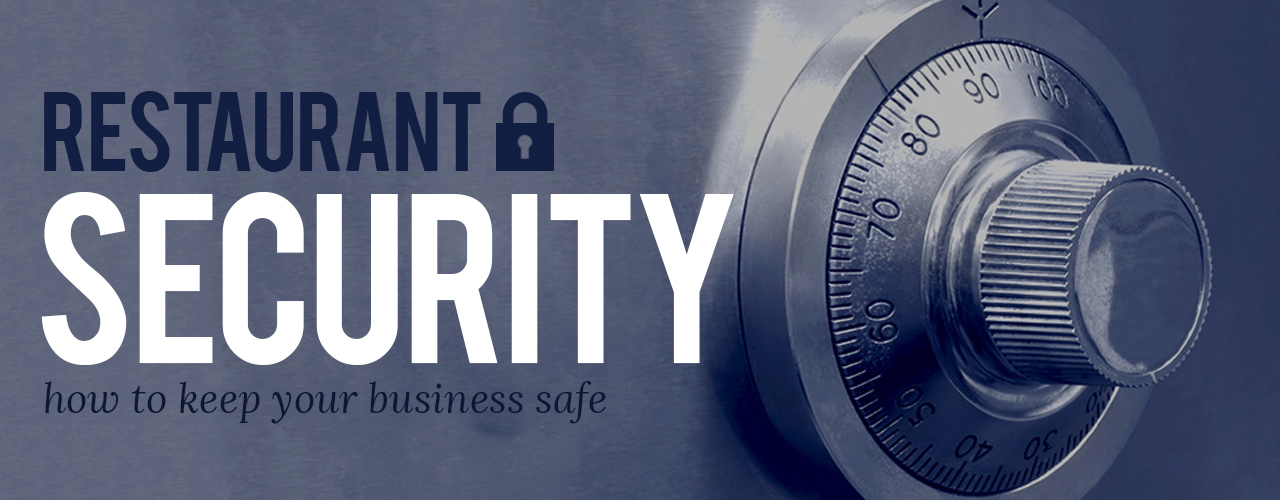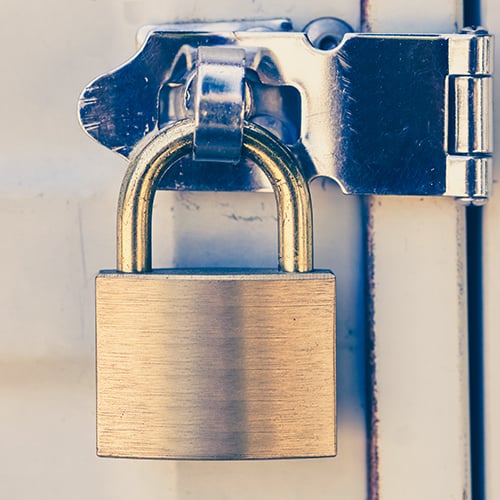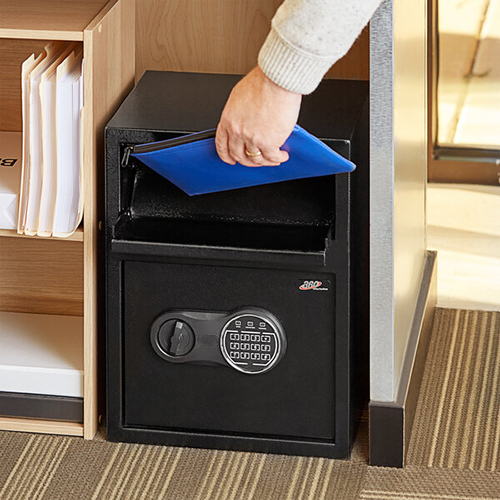
Restaurant Security: Monitoring, Deterrents & Potential Threats
Last updated on Nov 26, 2024Restaurant security plays a significant role in the well-being of your customers, the safety of your staff, and the long-term health of your business. No matter what aspect of the foodservice industry you serve, there are several steps you can take to ensure a safe and secure workplace. We’ll investigate different types of restaurant security equipment and the threats your business may face below.
Restaurant Security Systems
Every business should take security seriously, and one of the most effective ways to do so is by implementing a reliable security system. While investing in a restaurant security system may require an upfront cost, the benefits far outweigh the expenses. Security systems protect your business, assets, and reputation and provide peace of mind in the workplace. We’ve outlined essential types of restaurant security equipment below so that you can implement an effective restaurant security system.
1. Restaurant Security Cameras

Security cameras allow you to monitor your business at all times. They act as a deterrent to theft, vandalism, and other threats. By implementing them effectively, you can significantly decrease the threat of these crimes and maintain constant watch over your workplace. Some areas to consider placing a security camera in your restaurant include:
- Restaurant entrance
- Kitchen
- Dining room
- Cashier's area
- Back entrance/loading area
There are four main types of restaurant security cameras:
- Dome security cameras: These cameras provide a cost-effective surveillance option without compromising quality. They can be mounted on walls, ceilings, or even poles, providing flexibility in placement options. Their compact and discreet design makes them blend seamlessly into any environment without drawing unwanted attention. This is especially important in customer-facing areas, where you want to maintain a pleasant atmosphere without compromising security.
- Turret security cameras: Turret security cameras, also known as eyeball cameras, are a popular choice for outdoor surveillance due to their weatherproof design and ability to rotate horizontally. One of their key advantages is their ability to provide increased clarity at night, facilitating effective monitoring during non-operational hours when the lights are typically dimmed or turned off.
- Bullet security cameras: The bullet security camera is known for its sleek and cylindrical shape, resembling a bullet casing. They are typically the most expensive option on the market but offer several benefits for their price. They feature infrared capabilities and can withstand harsh weather and temperature conditions, making them suitable for outdoor use during winter and inside your walk-in freezers.
- 360 security cameras: These cameras offer a 360-degree view, allowing you to monitor every corner of a room from a single device. This comprehensive view eliminates blindspots and reduces the number of cameras needed throughout your workplace. They are perfect for highly-trafficked areas such as dining rooms or crowded bars.
2. Restaurant Locks

Investing in high-quality, dependable locks is an easy way to increase workplace security. By outfitting your doors with proper locks, you can prevent intruders from entering your restaurant and restrict access to certain rooms or areas. Conversely, choosing the wrong locks can leave you vulnerable to theft, break-ins, and vandalism. To best protect your workplace, consider using a wide range of locks. We’ll investigate the different locks and what sets them apart below:
- Padlocks: Padlocks are versatile and not permanently attached to any doors or objects. Use them to secure gates, doors, storage areas, and lockers. There are two main types of padlocks: combination padlocks and keyed padlocks. Combination padlocks open with a combination, providing a convenient and keyless access solution. Keyed padlocks require a key, offer a higher level of security, and are used in situations where only authorized personnel should have access.
- Deadbolts: Deadbolts are installed inside external doors and offer more protection than standard locks. They are known for their increased durability and have various commercial applications. Deadbolts come in three main varieties: single deadbolts, double deadbolts, and lockable thumbturns. Single deadbolts are the most common type, featuring a key cylinder and a lockable thumbturn. Double deadbolts require a key to lock and unlock from both the inside and the outside. Lockable thumbturns offer the convenience of a thumbturn on the inside, but also have the added security of a key cylinder on the outside.
- Knob locks: A knob lock should be used on doors that require a basic level of security, such as office rooms or storage areas. However, knob locks should never be the sole security measure on external doors or doors. Knob locks feature an internal locking cylinder, making them relatively easy to install and replace but leaving them vulnerable to tampering or forced entry.
- Lever locks: One of the standout features of lever locks is their large push-down handle, making them ADA-accessible. Lever locks are also highly secure. With their sturdy construction and built-in mechanisms, they provide a reliable level of protection for your commercial space. Lever locks can be vulnerable to torque attacks, where force is applied to the handle to break the lock.
3. Restaurant Safes

Whether you’re protecting documents, currency, or other valuables, safes provide an extra layer of security for your restaurant. Where you place your safe can vary depending on the type of restaurant you run, but many people keep it in a manager's office. Be sure to choose the safe that best fits your needs. The most common types of restaurant safes include the following:
- Drop Safes: These short-term cash protection systems allow employees to quickly and securely add cash to a collection without needing constant access to the safe. Most drop safes also come equipped with phishing guards that prevent would-be thieves from using tools to fish out cash or other valuable items from the drop slot.
- Key cabinets: These lockable boxes prevent unauthorized access to keys, ensuring the security of your valuable assets. Key cabinets are accessible via combination code, meaning only those who know the code can access the keys stored inside.
- Hotel safes: Also known as wall safes, hotel safes hide and safeguard your valuables and deposits. They are recognized for their discrete nature, adding an extra layer of security since potential thieves won't be able to easily locate and access the safe.
- Fireproof safes: These safes can withstand extremely high temperatures and protect valuables from flames. By providing a barrier against heat, fireproof safes prevent items from melting, warping, or becoming irreparably damaged. They are ideal for storing contracts, legal papers, and financial records.
- Cash boxes: These compact and sturdy boxes provide a secure place to store your money. There are two distinct types of cash boxes: key lock cash boxes and combination lock cash boxes. By limiting cash box access to verified personnel, you can minimize the risk of internal theft.
Restaurant Threats
There are several different threats that a restaurant faces every day, and you should always be prepared to deal with them. We’ll outline some of the most common restaurant threats below:
Cash Theft

The more cash your restaurant deals with, the greater the risk of theft. One of the reasons cash theft is so prevalent is that physical currency is lightweight and untraceable. Unlike credit card transactions, where there is a digital record of each payment, cash can easily be pocketed and disappear without a trace, making it an attractive target for internal and external theft. To mitigate cash theft, follow these guidelines:
- Invest in a reliable cash management system: Using a cash management system can help reduce the risk of internal theft. These systems automate cash handling processes, such as counting and storing money, minimizing the opportunities for employees to steal cash.
- Train your staff: Educate your employees about the importance of cash handling procedures and the consequences of theft. Implement strict policies regarding cash management and regularly monitor cash handling practices to ensure compliance.
- Install security measures: Install security cameras both inside and outside your restaurant. Visible security cameras act as a deterrent to potential thieves and can help identify culprits.
- Conduct regular cash audits: Regularly auditing your cash transactions can help identify discrepancies or irregularities. By comparing cash register totals with actual cash on hand, you can quickly identify potential theft and take appropriate action.
Skimming
Skimming is a technique that criminals use to collect credit card information. Criminals install a skimming device on a legitimate point-of-sale terminal, such as a credit card reader. Once installed, it collects information stored on the magnetic stripe of a credit card when it is swiped for payment.
The consequences of falling victim to skimming can be severe. For your restaurant, it can lead to a damaged reputation and loss of customer trust. Word spreads quickly in the age of social media, and if customers hear that your establishment has been compromised, they may take their business elsewhere. To prevent skimming in your restaurant, follow these steps:
- Transparent checkout: Keep your POS system and payment processing machines in your guests and employees' line of sight to prevent foul play.
- Train your staff: Verify that your staff knows how to use your POS system and can recognize discrepancies.
- Inspect equipment: Regularly inspect your POS system and other related equipment to ensure a skimming device has not been installed.
Property Theft

Thieves can strike at any time, and their targets can be anything from expensive decor to simple disposables. One of the most common types of property theft in restaurants is internal theft, which occurs when employees take advantage of their access to steal valuable items. It could be a server pocketing some extra cash from the register or a line cook sneaking out with a box of steaks. Internal theft can be difficult to detect, as the culprits are often familiar faces who know the ins and outs of your operation.
External theft is equally prevalent in the restaurant industry. This type of theft occurs when individuals outside the establishment target your property. They may pose as customers or even wait for the right moment to strike when the restaurant is closed. To prevent property theft, implement the following practices:
- Install security cameras: Strategically placed security cameras can act as a deterrent and help capture evidence in case of theft. Cover all vulnerable areas including the dining room, kitchen, and storage spaces.
- Train your staff: Educate your staff about the importance of security and theft prevention. Teach them to be vigilant and report any suspicious activity immediately. Encourage an open and honest work environment where employees feel comfortable sharing their concerns.
- Conduct background checks: Conduct thorough background checks on prospective employees to minimize the risk of internal theft. This includes checking references, verifying employment history, and conducting criminal record checks.
- Implement access controls: Limit access to certain areas of your restaurant to authorized personnel only. This can be done through keycard systems or locked doors with restricted access.
- Secure valuable items: Keep valuable items locked away when not in use. Use lockable cabinets or safes to ensure these items are secure.
Break-Ins
One of the most obvious consequences of a break-in is the loss of inventory. Whether it's expensive cuts of meat, premium bottles of wine, or high-quality kitchen equipment, thieves can make off with valuable items that are essential to your operation. Cash from the register, personal belongings of staff members, and even customer belongings left in coat check areas can all be targeted. To prevent break-ins, follow these steps:
- Invest in a security system: Install cameras, alarms, and motion sensors to deter potential criminals.
- Secure entrances and windows: Reinforce doors and windows with sturdy locks, shatterproof glass, and security bars. Consider installing security film on windows to make them more resistant to break-ins.
- Invest in adequate lighting: Ensure your exterior and parking lot are well-lit. Criminals are less likely to target well-lit areas as they are easily visible to passersby.
- Regularly review security procedures: Train your staff on security-related situations such as suspicious individuals or unusual activities. Conduct regular security audits to identify vulnerabilities and address them promptly.
On-Site Violence
The well-being and safety of your employees should always be a top priority. When restaurant workers experience abuse or violence, it can have detrimental effects on their mental and emotional health. The trauma they endure from these incidents can lead to long-lasting psychological scars that may even force them to quit their jobs. For that reason, it's crucial to implement proactive measures that create a safe and secure work environment.
- Establish a zero-tolerance policy: Make it clear to both your staff and customers that any form of abuse or violence will not be tolerated. Display signs in visible areas of your establishment, such as near the entrance or in restrooms, stating that aggressive behavior will result in immediate removal from the premises.
- Train your staff: Provide comprehensive training to your employees on how to handle difficult situations and de-escalate conflicts. Teach them effective communication techniques and empower them to confidently address issues with customers. By equipping your staff with these skills, you can help prevent volatile situations from escalating into violence.
- Install security measures: Implementing security measures such as surveillance cameras, panic buttons, and alarm systems can act as deterrents and provide a sense of security for your employees.
- Foster a supportive workplace culture: Encourage open communication among your staff and create an environment and establish a system for anonymous reporting to protect employees who may fear retaliation to address potential threats before they escalate.
Staying informed on the topic of restaurant security is essential to the safety of your employees and customers. Whether you’re looking to invest in security equipment or trying to identify potential security threats, there are several factors to take into account. With the information above, you can take the proper steps to ensure a secure restaurant environment.





